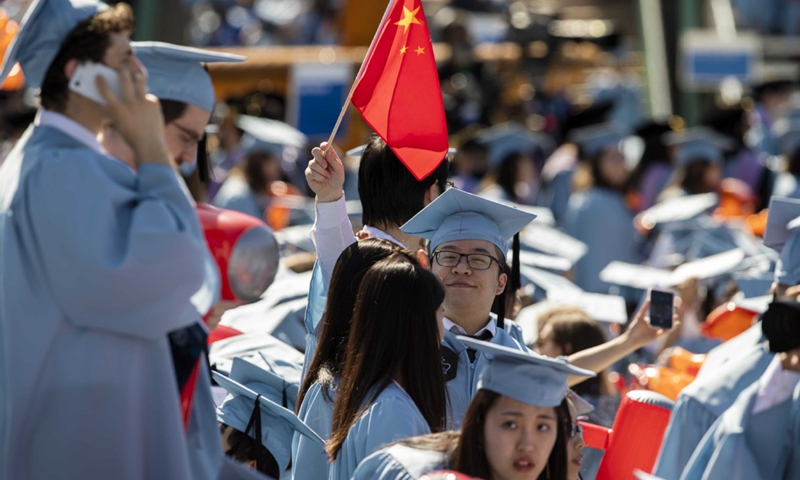US resumes accepting student visa applications, but some Chinese families rethink study plans

Graduate students from China attend the Columbia University Commencement ceremony in New York, the United States, May 22, 2019. Photo: Xinhua
The US embassy and consulates in China resumed accepting student visa applications on Tuesday, which was suspended last year amid the COVID-19. However, after the whole year fighting the pandemic, frequent attacks on Asians, and rising skepticism and even discrimination against Chinese students, they would be more cautious on making decisions to study in the US.
The move comes after the US lifted travel restrictions on several countries including China.
"Some students received good news, some received bad news," a Beijing-based consultant on applying US visa told the Global Times on Tuesday about the application results on the first day of resuming student visa application. He said that a small amount of students applying on Tuesday were rejected or checked by visa officers.
Chinese students from schools "with a military background" face tougher scrutiny and their chance of acquiring a visa is very slim.
"I have given up on studying in the US. There would be no hope for me (to go to the US)," Sinan, a PhD student in aerospace research, told the Global Times on Tuesday.
Sinan's school is among an alleged list of schools affected by a proclamation issued in May 2020 by former US President Donald Trump, which blocked certain Chinese students and scholars that "implement or support China's Military-Civil Fusion (MCF) strategy."
"My school and my major would both be too difficult to get a US visa," Sinan said. He decided to switch to Europe instead.
According to Sinan, some 200 students impacted by the proclamation have formed a chat group to discuss how to protect their rights.
Catherine, who has been enrolled by an Ivy League university but was unable to get there due to US travel restrictions, said students were excited about the recent move on lifting the restrictions in an online chatting group she joined. She said that some of them had previously planned to go to Thailand to apply for their visa.
Some said even though they could receive the visa, they still worry about the virus-prevention measures and anti-China sentiment in the US. Several students contacted by the Global Times expressed their concern that the US has not recognized the vaccines they have received in China.
Such worries have changed the mind of some Chinese students about studying in the US.
"Many of the students around me are still monitoring the situation. I know some have decided to give up American universities and changed to Europe or Japan, or chosen to work for a while," Cao Di, a senior student at University of International Business and Economics, told the Global Times.
The spread of the COVID-19 epidemic in the US and the country's polarization over the issue, as well as attacks on Asians, all have heightened the concerns of Chinese students, many of whom would avoid the US as their destination of studying abroad, Li Haidong, professor at the Institute of International Relations of the China Foreign Affairs University, told the Global Times on Tuesday.
"Though there would still be a big number of Chinese students going to the US, there would be a drop in the number comparing with that before the pandemic," Li said. "Chinese students and their parents lack sense of security about studying in the US."
William Bistransky, acting consul general at the US Embassy in China, said during a press conference on April 30 that the embassy will gear up visa processing for students once appointments officially re-opened.
In 2020, 382,000 Chinese students were studying in the US, accounting for 31% of overseas students. Data from the Association of International Educators shows the economic activity created by international students in the US decreased by $1.8 billion in the 2019-20 academic year from $40.5 billion in the previous year.

